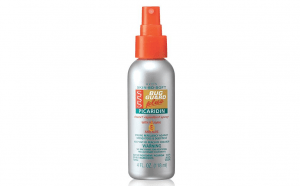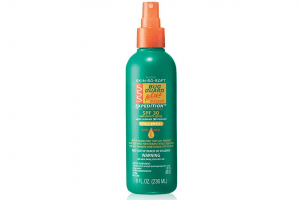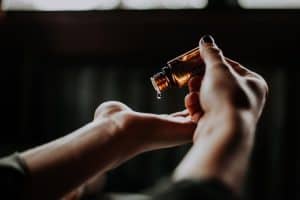Avon Skin So Soft Bug Guard Review

Avon has been around since the late 19th century. In the 1940’s, Avon helped with the war effort, and in the 1960’s the company came out with its world-famous Skin So Soft line. This is our Avon Skin So Soft Bug Guard review.
The Skin So Soft line of products did not mean to trigger the insect-related response that it did. I believe it came as some surprise to the execs that these products were being used as a kind of premium insect-repellent. It makes sense, when you think about it. Most insect-repelling items don’t smell or feel the best, to say the least. The ability to keep insects at bay and maintain soft and nourished skin was an unexpected double-threat, so to speak, which very much appealed to the everyday consumer.
Riding on that wave, presumably, Avon came out with their Bug Guard series.
Avon Bug Guard Line Breakdown
Studies have shown that N,N-Diethyl-meta-toluamide (aka DEET) is the most effective active ingredient in insect repellents. Unfortunately, it is also a chemical which can be harmful if misused. Avon wanted their Bug Guard line to be free of DEET and 4-Aminobenzoic acid (aka PABA) – so they created a series which makes use of icaridin (aka picaridin) and Ethyl butylacetylaminopropionate (aka IR3535), two compounds which are effective and which are considered to be less harmful, by and large. Just keep in mind that overusing any type of chemical, whether synthetic or not, can result in harm.
The line of Avon Skin So Soft Bug Guard products includes lotion, spray, and towelettes. Unlike the Avon Skin So Soft Bath Oil, which many use as an insect-repellent alternative, the Bug Guard series is an actual insect-repellent. It’s approved for children, adults, pregnant, and nursing women.
Depending on the activity and time of day, there is a Bug Guard product which will be more recommended. During nighttime, Plus Picaridin is your go-to. During the day, the IR3535 Expedition should keep your covered. If you’re outdoors, at a ballgame, in the pool, on the beach, and/or staying in areas with high humidity, one of the IR3535 lotions should prove to be a good match.
Avon Skin So Soft Bug Guard Plus Picaridin Review

Avon Skin So Soft Bug Guard Plus Picaridin.
Picaridin was first introduced in the 1980s, as a useful and synthetic insect, tick, and chigger-repellent. It was approved for commercial sale in the United States in 2005 and was subsequently added to various repellent formulas. You can use picaridin on your skin or clothes to keep you safe from bites. It’s not an insecticide (only works as a repellent), and it’s used in a wide range of insect-repellents, one of which is Avon’s Bug Guard.
Avon’s Bug Guard Plus Picaridin has one basic flaw, as far as I can tell – it doesn’t seem to last as long as the label says it does. I would chalk that up to bad marketing, not a failure on the part of the product, but I still wanted to include that tidbit. That said, it does a great job at keeping insects away. The added bonus of having that Avon scent and softness makes it a good product to keep around.
Because picaridin is a synthetic compound, it’s best to rinse it off of your body once you no longer need the protection. Studies have demonstrated that there is no real danger in using commercial picaridin products. The chemical will be sent out of the body through the urine, but you can never be too careful, and this is why rinsing it off is ideal.
Avon Skin So Soft Bug Guard Plus IR3535 Review

Avon Skin So Soft Bug Guard Plus IR3535.
Much like picaridin, IR3535 is not an insecticide, but a repellent. It is a derivative of a naturally-occurring amino acid. An added bonus of having the active ingredient be structurally similar to a naturally-occurring amino acid, is that it breaks down easily, and causes no harm to humans, animals, or the environment.
IR3535 was developed in the 1970s, and it took its sweet time getting around to the market. Nowadays, you can find it in many lotions, sprays, and aerosols. You can even apply it right before bed and go to sleep with it on your skin. No danger of chemical burns or other unpleasant occurrences.
Like the picaridin product, I take issue with the times. Maybe this was just my experience, but the protection didn’t seem to last as long as it should have. Sometimes, a different strain of mosquito will react differently to insect repellents.
This is a good place to add a common piece of advice. Don’t place 100% of your trust in these products. Dress in long clothing if you can, and avoid having to deal with these insects, to begin with. Obviously, there are no air-tight solutions, and I don’t think there is a single company that states that its products are effective all the time. There are too many different elements to factor in and control, the least of which is the person’s blood type.
DIY Bug Guard Recipe And Guide

Using essential oils on skin.
Among the relatively new bug guards, such as DEET, picaridin, and IR3535, there are also the classics: flower extracts, fruit extracts, and essential oils. These are methods that are tried and true. It’s perfect for a DIY bug spray.
It’s not too difficult concocting your own insect repellent, but you do need to use caution. Even though the DIY compounds (or ingredients) are considered safe and easy to use, substances like essential oils should be properly diluted and/or carefully applied.
That’s where the commercial products have an edge, I suppose. The contents are already approved, balanced, and it comes with the manufacturer’s instructions. Nevertheless, it is worth making such a product at home, because it can be significantly cheaper in the long run.
DIY Bug Spray Recipe
In a glass or glass bottle, pour half a cup of distilled water – (100ml)
In a separate glass or bottle, add:
Lemongrass essential oil – 2 drops
Basil essential oil – 2 drops
Clove essential oil – 2 drops
Citronella essential oil – 2 drops
Eucalyptus essential oil – 2 drops
Lavender essential oil – 2 drops
Fine table salt – half a teaspoon
Mix the oils and salt. Add the contents to the glass of distilled water. Mix well, and you’re good to go! It’s that simple.
You can use this DIY spray as a spray, but you can also use it as a substance for an essential oil diffuser. Keep the contents sealed, cool, and away from heat or humidity. Oxygen and warmth are no good for items like this. If the mixture is contaminated in any way – if it smells bad, looks bad, just seems off, or if it becomes ineffective – just make a new batch.
Essential oils are a highly potent and concentrated substance. This is why you only need 2 drops in this DIY spray. Feel free to change the recipe and add or subtract drops as needed, but keep in mind its power and its effects on the human body. Allergic reactions and/or irritations are very uncommon (especially with such small doses), but it does happen. These oils are meant for external use only, so be sure to seek medical attention if there are any issues.
Conclusion
Spring and summer bring a lot of amazing things along with them: rejuvenation, celebration, and joy. Even so, with all of our love for nature and all things natural, we don’t want to get bitten or assaulted by gnats, ticks, flies, mosquitoes, or any other pest or nuisance. Whether it’s indoors or out, we would rather avoid contact with these potentially-harmful life forms.
Avon has been in business for about 130 years now. I think it’s safe to say that they know their customers, they know their industry, and they know how much of an impact they can have on the public’s health and safety. For over a century, Avon has been a force to be reckoned with. Their line of DEET and PABA-free insect repellents are an excellent reminder of why this company is still considered one of the best in the business.


